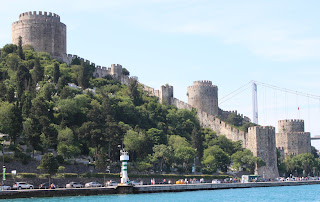The day after Sinan’s mosques was our “off day,” which I
decided to spend with the instructors and Josh on a half-day trip down the
Bosphorus that turned into an all-day affair where we got roped into a “4-hour
tour” by car and boat that exceeded all of our expectations. To begin with, none of the five of us
expected to spend over an hour in small sedan; neither Josh nor I expected half
our legs (his left and my right) to mimic paralysis most of the carried, and
none of us expected to see the Black Sea.
Yes, the ride up to the northern edge was less-than-ideal,
but the relatively minor discomfort was still fun and gave us all a lasting
memory. Along the way, we stopped at two
more mosques, the Rumeli (European) fortress and the coastal town of Kilyos
before embarking southward on an equally-full cruise boat. The sun was out all day and, by the end of
our seven-hour tour, all parties were worn out but impressed by the daytrip
north of Istanbul proper. Almost as soon
as it began, we were piling out of our clown car and into the most southern
coastal mosque north of the Galata Bridge.
Kilic Ali Paşa Mosque
Built by Sinan in 1580 when he was in his nineties, this
mosque was commemorated for one of the foremost admirals in the Ottoman
navy. Incredibly well maintained, this
was the first of any mosque that we visited to have exterior carpeting. Apparently, the Haghia Sophia inspired the
architect’s vision for this mosque, but I didn’t see it. More interesting was the man for which it was
commissioned. The Navy Admiral was born
in Italy, captured by Muslim pirates and later converted to Islam while serving
Süleyman the Magnificent, Selim II and Murat III.
Nusretiye Mosque
The only “truly Baroque” mosque visited during the entire
trip, this mosque was constructed in the 1820s by Kirkor Balyan but was closed
during our visit. Commissioned by Mahmut
II in 1826 to commemorate his victory over the janissary corps, this mosque
faced the barracks of his new army across the river. This style of mosque was not prevalent in the
city; however, most of the baroque mosques appeared to sit along the coast due
to all of the previously-commissioned mosques claiming the city’s hilltops.
Rumeli Fortress
The second military site visited during the trip (included
the Walls of Theodosius and excluded the Walls of Iznik), this fortress was
quite impressive for three reasons.
First, it was “finished” within four months, according to most sources. With towers exceeded twenty meters in height
and almost a kilometer of walls over unleveled terrain, this is impressive
given that Mehmet II constructed it in 1452 as the first step in his conquest
of Constantinople.
Second, this site was used in conjunction with the fortress
across the river to control traffic at the narrowest point along the
causeway. The adjacent fortress was
constructed by Beyazit I in his attempt at the beginning of the fourteen
hundreds to seize the city. Third, at
the base of its towers (both were closed and climbing to the true top of the
fortress impossible) it was impossible to see the city (or for it to see the
fortress). The engineer (Mehmet himself)
therefore masked the fortress behind an IV line, making counterattacks /
artillery difficult to be effective.
Kilyos
The most northern extent of our trip concluded in the tiny
seaside resort town of Kilyos, a former Genoese settlement still represented by
a 14th-Century castle perched on a cliff top overlooking the
town. We ate a smattering of meze (cold appetizer dishes) from a
second-floor restaurant sporting an unobstructed view of the Black Sea. Before too long, however, it was back into
the clown car for our return trip.
Bosphorus River Tour
The final experience for the day was a 90-minute boat tour
down the Bosphorus. Stopping twice on
the way to our final destination near the New Mosque port, the trip was packed
with likeminded tourists all inching toward a rail-side view. We kept toward the middle of the river,
making quality photographs impossible without a high-zoom lens (which I didn’t
bring!).
Notable spots along the way included the Fetih Mehmet
Bridge, the museum sitting under the eastern end of that bridge, Dolmabahçe Palace, the two mosques visited
earlier in the day and the old city’s skyline from Topkapi to the Blue Mosque. The water, to include that of the Black Sea,
was almost a fluorescent green-blue that most assuredly did not show as
spectacularly in any photographs.
In all, we covered about sixty kilometers round-trip, going
through the Belgrade Forest up to the Sea and back along the river. It was a good break from “mosque-hunting”
that quickly became the unofficial theme of the trip’s second half.
Further, like the trips to Bursa and Iznik, it helped
provide scale to one of the most popular “characters” of the course, that
river. It was large, winding and
hilly. Traveling it or across it was
formidable; I couldn’t imagine trying to conduct a naval assault along it, as
it was certainly an effective obstacle to any foreign maneuver.









No comments:
Post a Comment